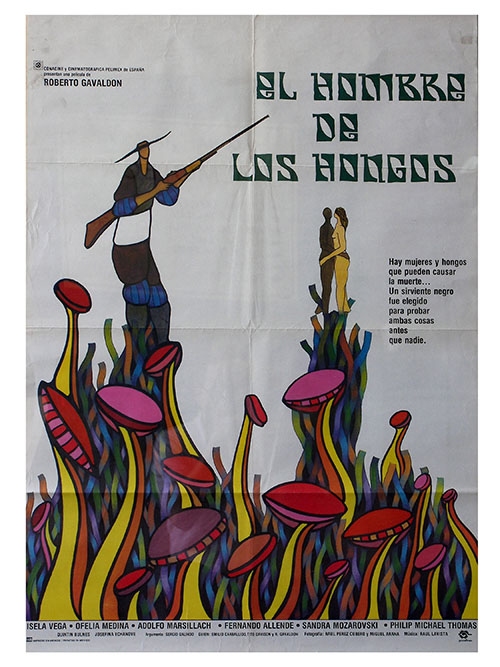 A most unique period piece from Mexico. THE MUSHROOM MAN (EL HOMBRE DE LOST HONGOS; 1976) was one of the final directorial efforts by the esteemed Roberto Gavaldón (1909-1986), who made some of Mexico’s greatest films (see the noirish IN THE PALM OF YOUR HAND/EL LA PALMA DE TU MATO, 1951, and the soulful B. Traven adaptation MACARIO, 1960). THE MUSHROOM MAN isn’t up to their standards, although it was an extremely ambitious Mexican-Spanish co-production.
A most unique period piece from Mexico. THE MUSHROOM MAN (EL HOMBRE DE LOST HONGOS; 1976) was one of the final directorial efforts by the esteemed Roberto Gavaldón (1909-1986), who made some of Mexico’s greatest films (see the noirish IN THE PALM OF YOUR HAND/EL LA PALMA DE TU MATO, 1951, and the soulful B. Traven adaptation MACARIO, 1960). THE MUSHROOM MAN isn’t up to their standards, although it was an extremely ambitious Mexican-Spanish co-production.
Adapted from an acclaimed novel by Sergio Galindo, it features some of Mexico’s top actors—including Isela Vega (coming off BRING ME THE HEAD OF ALFREDO GARCIA and DRUM), the popular Mexican singer/TV star Fernando Allende and the late child actress turned “Lolita” starlet Sandra Mozarowsky—but is perhaps most notable these days for the casting of the American Philip Michael Thomas (later of MIAMI VICE) in a pivotal role.
The setting is eighteenth century Mexico, where the mushroom obsessed landowner Everardo discovers a dark skinned orphan boy while hunting in a ‘shroom field. Everardo names the boy Gaspar and brings him back to his plantation, where Gaspar quickly becomes one of the family.
This family has some disturbing proclivities, among them the unfortunate habit of feeding mushrooms to their slaves to see if they’re poisonous. If the servants die, as is oftimes the case, that means the ‘shrooms are indeed deadly. A dangerous panther named Toy is also kept on the premises that Everardo’s wife Elvira wants killed, but Everardo continually refuses her requests.
This family has some disturbing proclivities, among them the unfortunate habit of feeding mushrooms to their slaves to see if they’re poisonous…
Gaspar upends life in the plantation considerably, with the fact that he’s dark-skinned definitely not lost on his lily-white “family.” As he grows to young adulthood Gaspar initiates a torrid affair with Everardo’s daughter Emma, causing great dissention.
Things come to a head when Elvira has her throat ripped out by Toy. Emma continues her affair with Gaspar, at one point heading out to the field where he was found, where they partake of the mushrooms growing therein. Those mushrooms turn out to have psychedelic properties, inspiring some very seventies-centric hallucinations. Everardo is upset about the union, and decides to have Gaspar killed; the latter, however, has his own equally unpleasant ideas of how to deal with Everardo and the family.
The old timey melodrama of Roberto Gavaldón’s earlier films seems out of place in the 1970s, yet THE MUSHROOM MAN is steeped in it.
Soap opera is the correct term for all this. The old timey melodrama of Roberto Gavaldón’s earlier films seems out of place in the 1970s, yet THE MUSHROOM MAN is steeped in it. Stiff where it should be loose, formal where it should be freewheeling and far too talky for its own good, the film is a miscalculation that feels needlessly drawn out and lacking in human interest. Virtually all the characters are selfish and unpleasant, leaving the viewer with nobody to side with, much less root for. The best part is the delirious hallucinogen-fueled climax (which directly anticipates Gaspar Noe’s CLIMAX), but it’s not enough to redeem an otherwise lackluster snooze fest.
Vital Statistics
THE MUSHROOM MAN (EL HOMBRE DE LOS HONGOS)
CCP/ Cinematográfica Pelimex/ Conacite Uno/ Corporación Nacional Cinematográfica
Director: Adolfo Marsillach
Producers: Anuar Badin, Rafael Vázquez Fajardo
Screenplay: Emilio Carballido, Tito Davison, Roberto Gavaldón, Fernando Vizcaíno Casas
(Based on a novel by Sergio Galindo)
Cinematography: Miguel Araña, Raúl Pérez Cubero
Editing: José W. Bustos
Cast: Isela Vega, Adolfo Marsillach, Ofelia Medina, Fernando Allende, Sandra Mozarowsky, Philip Michael Thomas, Quintin Bulnes, Josefina Echánove, George Belanger, Ana Graham, Emma Gabriela Navarro, Fernando Sloniso, Luis Miguel Jacob
